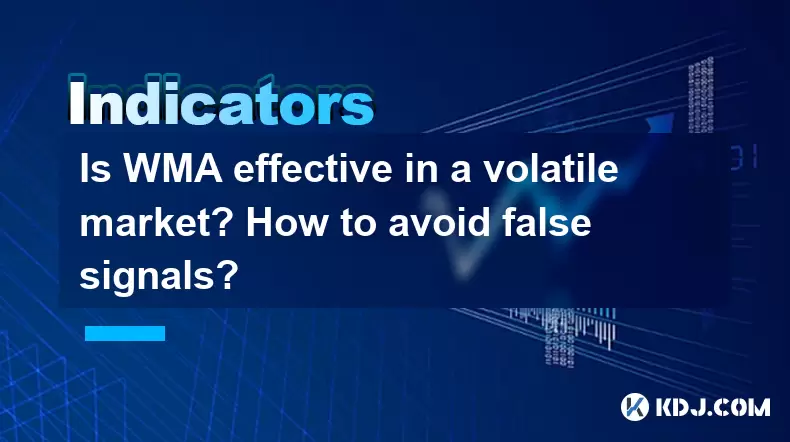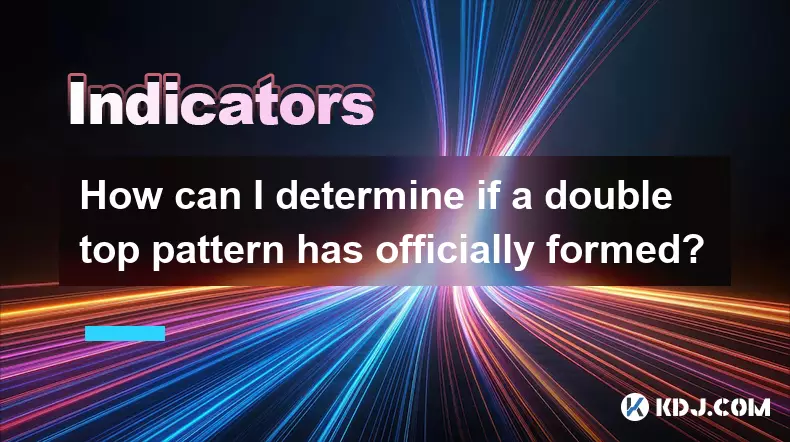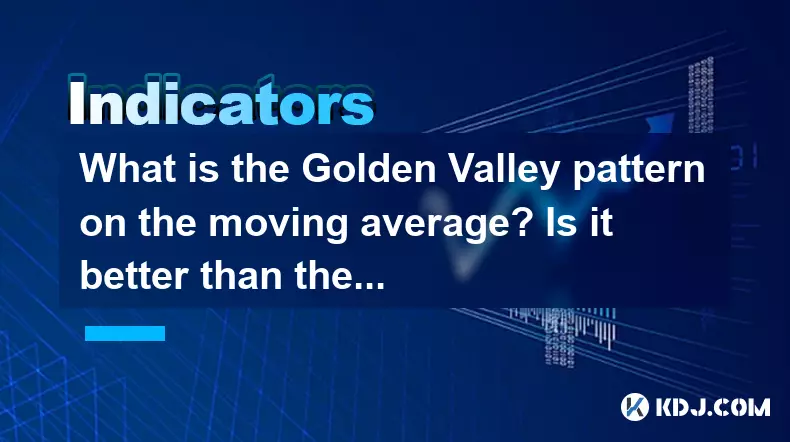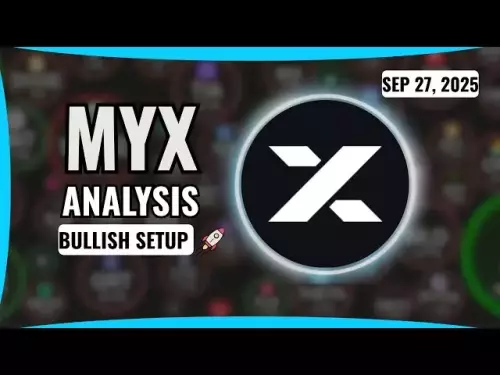-
 bitcoin
bitcoin $109523.663807 USD
-0.13% -
 ethereum
ethereum $4019.526508 USD
2.06% -
 tether
tether $1.000482 USD
0.00% -
 xrp
xrp $2.776815 USD
0.18% -
 bnb
bnb $958.942396 USD
0.12% -
 solana
solana $204.294698 USD
3.84% -
 usd-coin
usd-coin $0.999693 USD
0.00% -
 dogecoin
dogecoin $0.232115 USD
2.09% -
 tron
tron $0.338028 USD
0.84% -
 cardano
cardano $0.790920 USD
1.50% -
 hyperliquid
hyperliquid $44.871443 USD
5.60% -
 ethena-usde
ethena-usde $1.000322 USD
0.04% -
 chainlink
chainlink $21.034165 USD
2.60% -
 avalanche
avalanche $28.794831 USD
-0.54% -
 stellar
stellar $0.360466 USD
1.24%
Is WMA effective in a volatile market? How to avoid false signals?
WMA is effective in volatile crypto markets but can generate false signals; using it with other indicators and multiple time frames can improve reliability.
May 21, 2025 at 08:14 pm

The Weighted Moving Average (WMA) is a popular technical analysis tool used by traders in the cryptocurrency market to smooth out price action and identify trends. Given the volatile nature of the crypto market, understanding whether WMA is effective in such conditions and how to mitigate the impact of false signals is crucial for traders. This article delves into the effectiveness of WMA in volatile markets and provides strategies to avoid false signals.
Understanding WMA and Its Application in Crypto Trading
The Weighted Moving Average (WMA) assigns more weight to recent prices compared to older prices, making it more responsive to new information than a simple moving average. This characteristic is particularly useful in the cryptocurrency market, where prices can change rapidly. The formula for WMA is:
[ \text{WMA} = \frac{n \cdot Pn + (n-1) \cdot P{n-1} + \ldots + 2 \cdot P_2 + 1 \cdot P_1}{n + (n-1) + \ldots + 2 + 1} ]
Where ( n ) is the number of periods, and ( P ) represents the price at each period. This calculation ensures that the most recent prices have a greater impact on the average, which can help traders react more quickly to market changes.
In the context of volatile markets, the responsiveness of WMA can be both an advantage and a challenge. The advantage lies in its ability to reflect recent price movements more accurately, allowing traders to make timely decisions. However, the challenge is that this same responsiveness can lead to more frequent signals, some of which may be false.
Effectiveness of WMA in Volatile Markets
In volatile markets, the effectiveness of WMA depends largely on the trader's ability to interpret its signals correctly. The WMA's responsiveness can help traders identify trends and potential reversals more quickly than other moving averages. For example, during a sudden price surge or drop, the WMA will adjust more rapidly, providing traders with an earlier indication of a potential trend change.
However, the rapid adjustments of the WMA can also result in more frequent signals, which may not always be reliable. In highly volatile conditions, the WMA might generate signals that are quickly reversed, leading to false positives or false negatives. Therefore, while WMA can be effective in volatile markets, traders need to use additional tools and strategies to filter out false signals.
Strategies to Avoid False Signals with WMA
To mitigate the impact of false signals, traders can employ several strategies when using WMA in volatile markets:
Combine WMA with Other Indicators: Using WMA in conjunction with other technical indicators can help confirm signals. For instance, combining WMA with the Relative Strength Index (RSI) or the Moving Average Convergence Divergence (MACD) can provide a more comprehensive view of market conditions. If both the WMA and another indicator suggest a trend, the signal is more likely to be reliable.
Use Multiple Time Frames: Analyzing WMA on different time frames can help filter out false signals. A signal that appears on both a short-term and a long-term chart is more likely to be valid. For example, if the WMA on a 15-minute chart suggests a bullish trend, but the WMA on a daily chart does not, the signal on the shorter time frame might be a false positive.
Implement a Confirmation Period: Setting a confirmation period before acting on a WMA signal can reduce the likelihood of false signals. For example, if the WMA crosses above the price, wait for a certain number of periods to confirm the trend before entering a trade. This approach helps ensure that the signal is not a short-lived anomaly.
Adjust WMA Parameters: Experimenting with different periods for the WMA can help find a balance between responsiveness and reliability. A shorter period will make the WMA more sensitive to price changes, while a longer period will smooth out volatility but may delay signals. Traders need to find the right balance based on their trading style and the specific market conditions.
Practical Example of Using WMA in a Volatile Market
To illustrate how WMA can be used effectively in a volatile market, consider the following example with Bitcoin (BTC):
Step 1: Set Up WMA on a Chart: Open a trading platform and select a Bitcoin chart. Add a WMA with a period of 20 to the chart.
Step 2: Monitor WMA Crossovers: Watch for the WMA to cross above or below the price. A crossover above the price may indicate a bullish trend, while a crossover below the price may indicate a bearish trend.
Step 3: Confirm with Additional Indicators: Add the RSI to the chart. If the WMA crosses above the price and the RSI is above 50, it strengthens the bullish signal. Conversely, if the WMA crosses below the price and the RSI is below 50, it strengthens the bearish signal.
Step 4: Check Multiple Time Frames: Look at the same signals on a 1-hour chart and a 4-hour chart. If the signals align across these time frames, it increases the likelihood that the signal is valid.
Step 5: Implement a Confirmation Period: After identifying a signal, wait for three periods to confirm the trend. If the WMA remains above or below the price for three consecutive periods, the signal is more likely to be reliable.
Step 6: Execute the Trade: Once the signal is confirmed, enter the trade based on the direction indicated by the WMA and supporting indicators.
Limitations of WMA in Volatile Markets
While WMA can be effective in volatile markets, it is important to recognize its limitations. The responsiveness of WMA can lead to frequent signals, some of which may be false. Additionally, WMA alone may not be sufficient to make informed trading decisions in highly volatile conditions. Traders must use it as part of a broader strategy that includes other technical analysis tools and risk management techniques.
Integrating WMA with Risk Management
Effective risk management is essential when using WMA in volatile markets. Traders should consider the following risk management strategies:
Set Stop-Loss Orders: Always set stop-loss orders to limit potential losses. The stop-loss level should be based on the volatility of the market and the trader's risk tolerance.
Use Position Sizing: Adjust the size of your positions based on the volatility of the market. In highly volatile conditions, smaller positions can help manage risk.
Diversify Trades: Avoid putting all your capital into a single trade. Diversifying across different cryptocurrencies and strategies can help mitigate risk.
Monitor Market Conditions: Stay informed about market news and events that could impact volatility. Adjust your trading strategy accordingly to manage risk effectively.
Frequently Asked Questions
Q1: Can WMA be used effectively in less volatile markets?Yes, WMA can be used effectively in less volatile markets as well. In such conditions, the WMA will generate fewer signals, which are more likely to be reliable. Traders can use longer periods for the WMA to further smooth out price action and reduce the frequency of false signals.
Q2: How does WMA compare to other types of moving averages in volatile markets?WMA is more responsive to recent price changes compared to Simple Moving Average (SMA) and Exponential Moving Average (EMA). While this responsiveness can be beneficial in volatile markets, it can also lead to more false signals. SMA is less responsive and may lag in fast-moving markets, while EMA strikes a balance between responsiveness and smoothing.
Q3: Is it necessary to use WMA on multiple time frames in volatile markets?Using WMA on multiple time frames is not strictly necessary, but it can significantly improve the reliability of signals. Analyzing WMA on different time frames helps confirm trends and reduces the likelihood of acting on false signals, which is particularly important in volatile markets.
Q4: Can WMA be used for both short-term and long-term trading in volatile markets?Yes, WMA can be used for both short-term and long-term trading in volatile markets. For short-term trading, use a shorter period for the WMA to capture quick price movements. For long-term trading, use a longer period to smooth out volatility and identify more sustained trends. Adjusting the WMA period based on your trading horizon can help tailor the tool to your specific strategy.
Disclaimer:info@kdj.com
The information provided is not trading advice. kdj.com does not assume any responsibility for any investments made based on the information provided in this article. Cryptocurrencies are highly volatile and it is highly recommended that you invest with caution after thorough research!
If you believe that the content used on this website infringes your copyright, please contact us immediately (info@kdj.com) and we will delete it promptly.
- BTC, Hard Fork, and Disputed Futures: A Bitcoin Knots Controversy
- 2025-09-28 01:05:16
- Litecoin, Remittix, and Crypto Payments: A New Era?
- 2025-09-28 01:05:16
- Crypto Presales: Is $BFX the Next Big Thing?
- 2025-09-28 00:25:12
- Kraken's IPO Ambitions: Navigating Valuation in a Recovering Crypto Market
- 2025-09-28 00:25:12
- World Liberty Financial (WLFI): Buyback & Burn Bonanza - Will the Price Ignite?
- 2025-09-28 00:45:12
- Bitcoin's Bumpy Ride: Navigating Risks and Potential Downturns
- 2025-09-28 00:30:01
Related knowledge

What is a tower bottom candlestick pattern? Does it have a high success rate?
Sep 22,2025 at 07:18am
Tower Bottom Candlestick Pattern Explained1. The tower bottom candlestick pattern is a reversal formation that typically appears at the end of a downt...

What is a black hole pattern in the MACD indicator? Is it a cause for concern?
Sep 21,2025 at 06:54pm
Bitcoin's Role in Decentralized Finance1. Bitcoin remains the cornerstone of decentralized finance, serving as a benchmark for value and security acro...

How can I use the psychological line (PSY) to determine market sentiment?
Sep 17,2025 at 02:19pm
Understanding the Psychological Line (PSY) in Cryptocurrency TradingThe Psychological Line, commonly referred to as PSY, is a momentum oscillator used...

How can I determine if a double top pattern has officially formed?
Sep 21,2025 at 03:18am
Understanding the Structure of a Double Top Pattern1. A double top pattern consists of two distinct peaks that reach approximately the same price leve...

What is the Golden Valley pattern on the moving average? Is it better than the Silver Valley pattern?
Sep 21,2025 at 02:54pm
Understanding the Golden Valley Pattern in Moving Averages1. The Golden Valley pattern is a technical formation observed in cryptocurrency price chart...

What does a death cross of the RSI in the strong zone (above 50) mean?
Sep 17,2025 at 10:54pm
Understanding the Death Cross in RSI Context1. The term 'death cross' is traditionally associated with moving averages, where a short-term average cro...

What is a tower bottom candlestick pattern? Does it have a high success rate?
Sep 22,2025 at 07:18am
Tower Bottom Candlestick Pattern Explained1. The tower bottom candlestick pattern is a reversal formation that typically appears at the end of a downt...

What is a black hole pattern in the MACD indicator? Is it a cause for concern?
Sep 21,2025 at 06:54pm
Bitcoin's Role in Decentralized Finance1. Bitcoin remains the cornerstone of decentralized finance, serving as a benchmark for value and security acro...

How can I use the psychological line (PSY) to determine market sentiment?
Sep 17,2025 at 02:19pm
Understanding the Psychological Line (PSY) in Cryptocurrency TradingThe Psychological Line, commonly referred to as PSY, is a momentum oscillator used...

How can I determine if a double top pattern has officially formed?
Sep 21,2025 at 03:18am
Understanding the Structure of a Double Top Pattern1. A double top pattern consists of two distinct peaks that reach approximately the same price leve...

What is the Golden Valley pattern on the moving average? Is it better than the Silver Valley pattern?
Sep 21,2025 at 02:54pm
Understanding the Golden Valley Pattern in Moving Averages1. The Golden Valley pattern is a technical formation observed in cryptocurrency price chart...

What does a death cross of the RSI in the strong zone (above 50) mean?
Sep 17,2025 at 10:54pm
Understanding the Death Cross in RSI Context1. The term 'death cross' is traditionally associated with moving averages, where a short-term average cro...
See all articles









































































